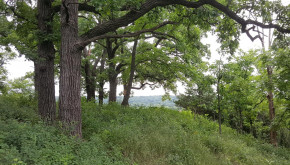
About 10 years ago, Indian Heights Park overrun with invasive plants while mountain bike tires were eroding the hillsides, park neighbors and Audubon members became concerned. Many neighbors and community members enjoyed the park, but none of us really understood how valuable the land was to our history, culture and wildlife. In 2010, we gathered the stakeholders together to share that this was (and is) an important site for Dakota people and that the city’s remnant oak savanna remains one of the most endangered ecosystem in Minnesota. Moreover, the World Wildlife Fund classifies this as - “the oak savanna component of the Upper Midwest Forest Savanna Transition Zone is one of the world’s most endangered ecosystems.” In other words, if we loved this land and found it to be sacred, then it was worth saving.
With new facts under our belts, we sought to restore the oak savanna to increase wildlife habitat and add to the public’s understanding of urban habitats. With City Park Board approval, we applied for a state-funded restoration grant as well as a planning grant from the National Park Service.
Two years into the restoration grant, we have buckthorn, honeysuckle and garlic mustard removal under control and since then we have enjoyed seeing native plants spontaneously springing up from the seedbank, most notably the frilly-puccoon and the nodding lady’s tresses orchid. Additionally, we now have a nesting pair of Cooper’s hawks, an occasional bluebird, bald eagle, and summer tanager, not to mention the annual visit of a red headed woodpecker. Red headed woodpeckers thrive in savannas- so we are sure we are on the right path.
While there are many names for native plants (e.g., weeds, noxious weeds, volunteers, pollinators,) I learned that when Dakota spiritual people say Medicine – they most often mean native plants. This gives me a whole other perspective on the value of these plants to their cultural and spiritual practice.
Of all our surprising events, the most memorable was when the United States Department of Homeland Security indicated (very quietly) I should not allow chainsaws or other machinery in the park due to a prominent international leader’s long-term stay in a nearby home. Never a dull moment!
My infinity of activities- attending board meetings, researching park history, speaking with Dakota elders, and promoting the sane use of herbicides, has led me into a brand new profession, that of Invasive Plant Program Coordinator for the University of Minnesota Extension. I am thrilled that these 37 city acres never stop providing a facility for habitats and growth at all levels for us humans; personal, professional, social and community. If you are in Rochester, please come and visit http://foih.org/
Story, photo, enthusiasm and dedication provided by Dawn Littleton

